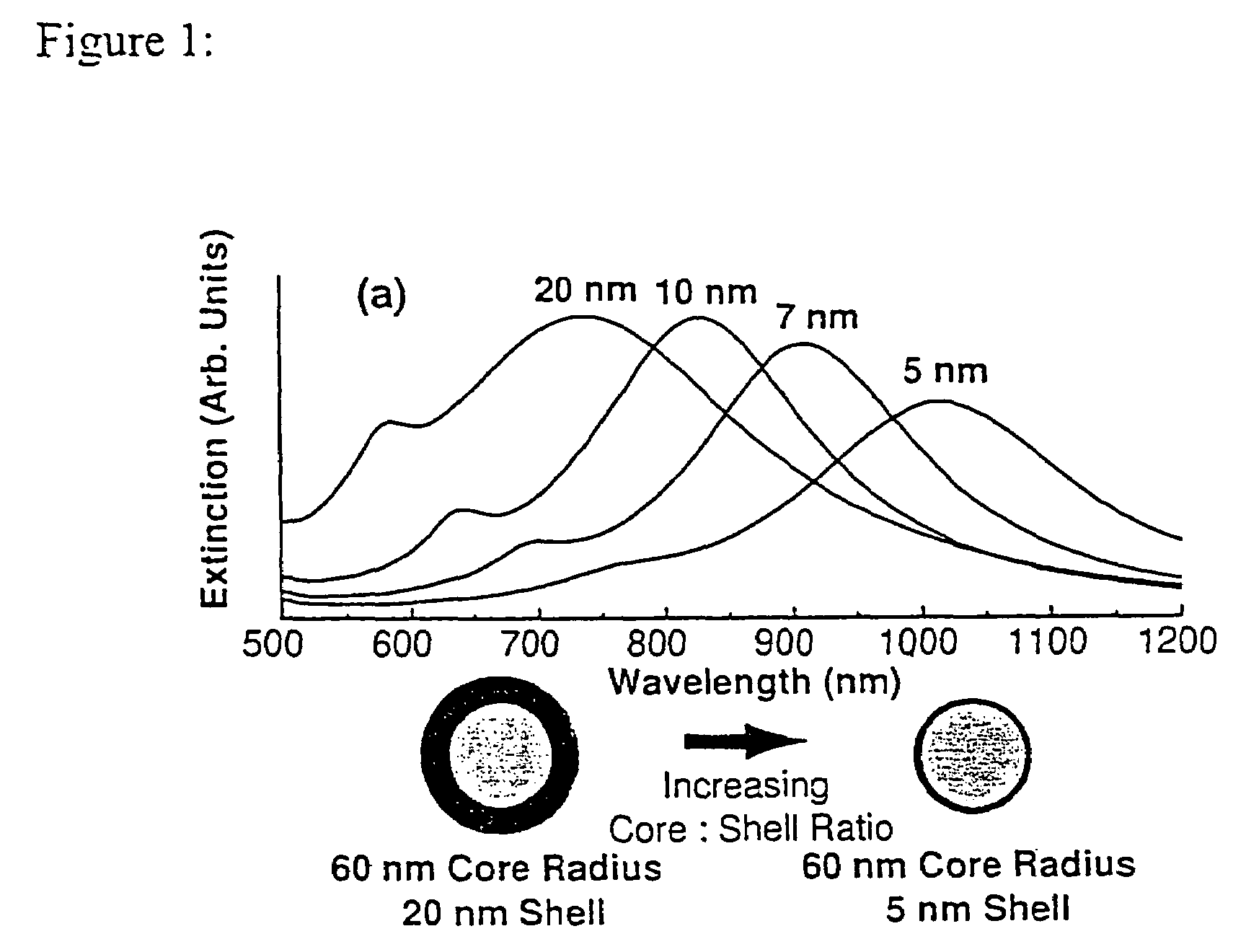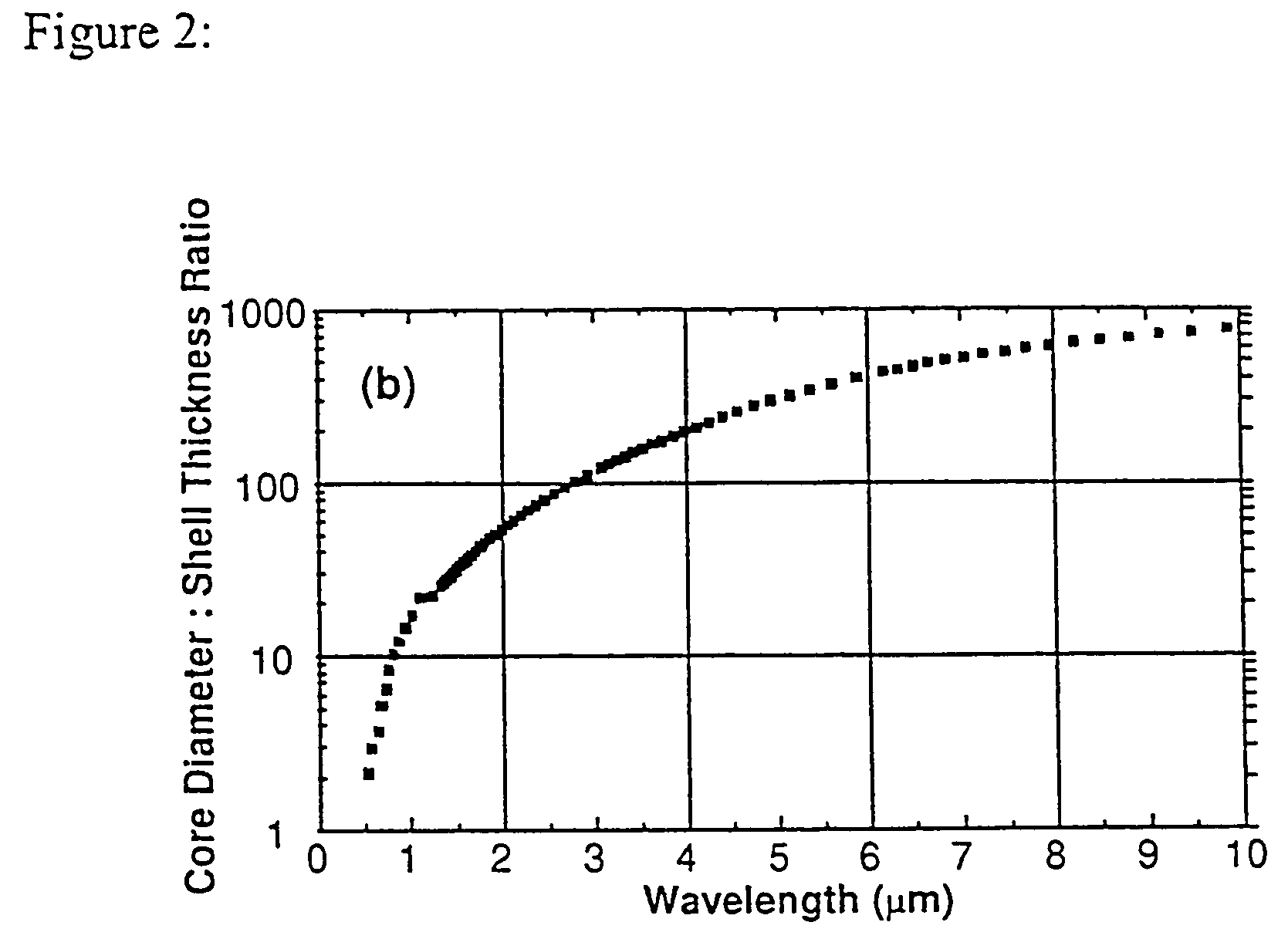Nanoparticle comprising nanoshell of thickness less than the bulk electron mean free path of the shell material
a nanoparticle and shell material technology, applied in the direction of nuclear engineering, natural mineral layered products, synthetic resin layered products, etc., can solve the problems of limited utility of these solutions, inability to position the plasmon resonance at technologically important wavelengths, and application of solid metal nanoparticles. achieve the effect of enhancing polarization at the plasmon resonan
- Summary
- Abstract
- Description
- Claims
- Application Information
AI Technical Summary
Benefits of technology
Problems solved by technology
Method used
Image
Examples
example i
General Method for Metal Nanoshell Colloid Based Synthesis
[0051]Versatile methods for the synthesis of nanoparticle cores and metal shells of defined sizes have been developed and are described below. Generally, the method comprised the following steps:[0052](1) first a dielectric or semiconductor nanoparticle core was obtained and dispersed in solution;[0053](2) then 1-2 nm metal-like “seed” colloids were attached to the surface of the nanoparticle core via molecular linkages, covering the core surface with a discontinuous metal colloid layer;[0054](3) finally, additional metal was deposited onto the metal-like adsorbates by a solution phase chemical reduction reaction.
[0055]This nanoparticle assembly method was carried out with silica nanoparticles and gold colloid. Both commercially available silica nanoparticles and silica nanoparticles grown in situ were used successfully. The organosilane linkage molecule 4-aminopropyltriethoxy silane was absorbed onto the nanoparticle core. G...
example ii
Core Particle Synthesis
[0056]Initially a core material for the nanoparticle was prepared. This material had a spherical shape, and was approximately uniform in size. The silica particles produced in the following procedure had a standard deviation of less than 10% (4% is routinely achievable).
[0057]The method of Stober (1968), incorporated herein by reference to the extent it provides such methods, was used to produce monodisperse silicon dioxide particle cores. Tetraethyl orthosilicate (TEOS) 99.999% was obtained from Aldrich Chemical Co., sodium hydroxide was from Fluka Chemical Co. and highly purified water was obtained from a Millipore “TOTALQ” system that included “MILLIQUV” and “MILIQRO” filters. All glassware was cleaned with chromic acid solution and thoroughly rinsed with “TOTALQ” water.
[0058]Variations in water, base concentration, and TEOS concentration were used to produce monodisperse silica spheres of various sizes. Temperature and electrolyte concentration also affect...
example iii
Linker Molecule Attachment
[0060]To assemble a metallic shell around an inner layer frequently required the use of linker molecules. These molecules were chemically linked to the inner layer and served to bind atoms, ions, atomic or molecular clusters of the conducting shell to the inner layer. The conducting shell atoms that bound to the linkers were used as nucleation sites for reduction of the additional atoms or molecules to complete the shell. One method used to attach gold particles to silicon dioxide was to treat the particles with aminopropyltriethoxy silane (APTES). The silanol end groups of the APTES molecules attach covalently to the silica core extending their amine groups outward as a new termination of the particle surface.
[0061]In this method, 10 ml of a silica particle suspension such as prepared in Example III, was added to a 50 ml glass beaker. Next, pure aminopropyltriethoxy silane (APTES) was added to the solution. Based on estimates enough silane was added to coa...
PUM
| Property | Measurement | Unit |
|---|---|---|
| Length | aaaaa | aaaaa |
| Fraction | aaaaa | aaaaa |
| Fraction | aaaaa | aaaaa |
Abstract
Description
Claims
Application Information
 Login to View More
Login to View More - R&D
- Intellectual Property
- Life Sciences
- Materials
- Tech Scout
- Unparalleled Data Quality
- Higher Quality Content
- 60% Fewer Hallucinations
Browse by: Latest US Patents, China's latest patents, Technical Efficacy Thesaurus, Application Domain, Technology Topic, Popular Technical Reports.
© 2025 PatSnap. All rights reserved.Legal|Privacy policy|Modern Slavery Act Transparency Statement|Sitemap|About US| Contact US: help@patsnap.com



